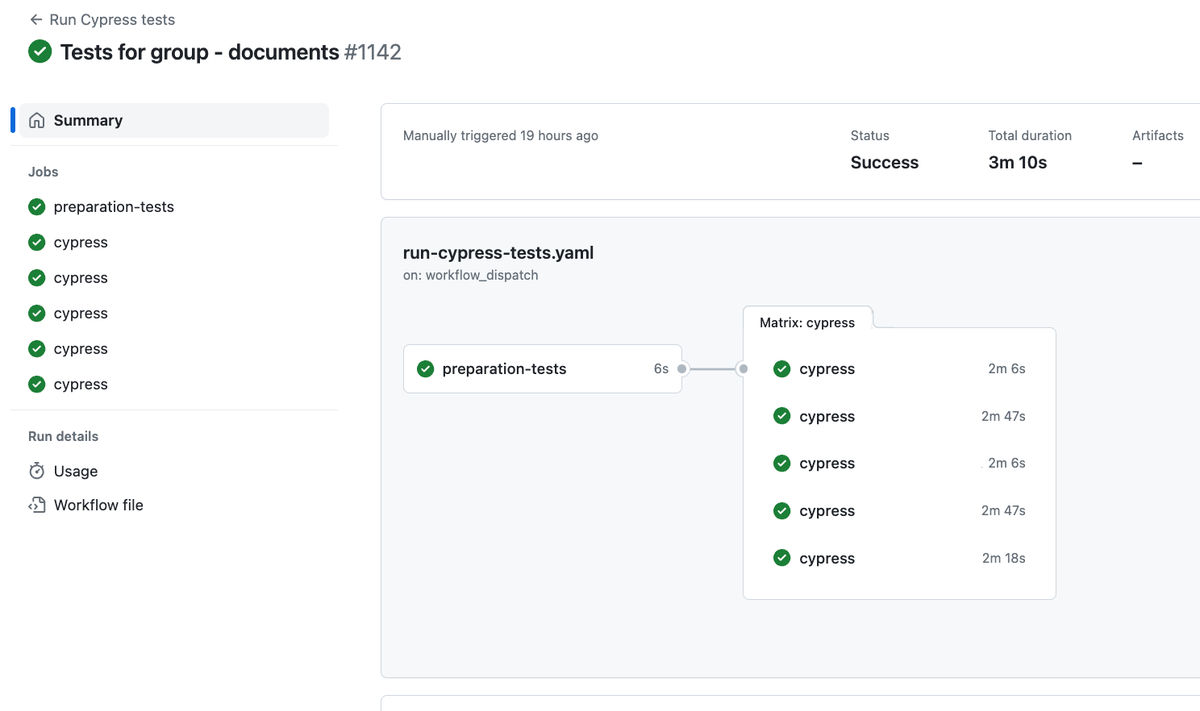Running Cypress tests with nested parallelization and GitHub Actions

At some point, as our test suite grows larger, we will face the issue of our tests taking longer to execute. This problem can affect suites written in various frameworks to different degrees. This issue can be particularly relevant for Cypress, which does not perform very well in benchmarks related to the speed of test execution.
A natural reaction at this point might be to switch to a different technology and rewrite the tests to improve their speed. However, it's important to remember that speed is just one of the factors for which a particular framework is chosen, among others, like ease of debugging, stability, and community support.
Nevertheless, speed is one of the key elements in test execution. Every time we run tests, we would like to receive feedback about the state of our software as quickly as possible. Therefore, I would like to share one of the ways we managed to reduce execution time of Cypress tests.
There are plenty of ways to run Cypress tests in parallel:
- Cypress Dashboard - paid solution
- Sorry-Cypress - free alternative to Cypress Dashboard
- Cypress-parallel - small npm package to run Cypress tests in parallel
- Manual split using GitHub Actions matrix strategy
- Cypress-split plugin from Gleb Bahmutov
Most of these methods are quite simple to configure. Typically, it's enough to use the appropriate actions within GitHub Actions and specify the number of workers that should run concurrently, just like in cypress-split.
Problems arise when you cannot use simple solutions in your current environment, such as on a GitHub Actions worker where you may have restrictions on installing external dependencies or passing secrets to Cypress, or when you need to use Docker to run Cypress.
In such cases, you can consider using a custom solution tailored to your specific environment constraints.
The method I am going to show you consists of combining the two methods mentioned above: manual splitting and the usage of the package cypress-parallel npm package. This approach is totally free.
- GitHub actions matrix strategy - is a way to split jobs across different workers. More info here
- Cypress-parallel - is a small npm package which is parallelizing the test run on the same machine. It searches for existing Cypress tests, splits them on different threads and collects reports.
GitHub Actions parallel workflow
The approach
Let's begin by outlining the structure of our approach step by step:
- Divide the available tests into main groups based on the main areas of testing.
- Further divide these main groups into subgroups based on more specific testing criteria.
- Use a GitHub Actions workflow to distribute the execution of these subgroup tests across parallel GitHub Actions workers.
By organizing the tests into main groups and subgroups, we can achieve better test management and parallelization.
Division into main groups
First, we split our Cypress tests into groups based on the main areas of testing. This can be divided based on our applications or main functionalities.
For example, if our application is an online store, the main testing areas would be:
- Registration
- Adding to cart
- Logging in
- Purchasing process
Therefore, in the folder where Cypress is located, we create directories corresponding to our main areas. Example structure of directories:
- registration
- login
- cart
- product_page
In the next step, you can divide your test structure even more granularly. The decision depends on how many automated tests you have and how complex your application's structure is. For example, you might want to divide the registration test group into smaller subgroups based on the affiliate partner or the source from which the user comes.
You can also skip this step and move to the step with the GitHub Actions workflow.
Split into subgroups
We divide the main testing groups into subgroups of testing. For registration, this could be subgroups like:
- registration_redirected
- registration_direct
- registration_other
Similar to the first step, we create new directories. In each subgroup, there are tests verifying the operation of the application/components. At this stage, the structure of our tests could look like this:
- registration
- registration_redirected
- registration_partner_a.cy.js
- registration_partner_b.cy.js
- registration_direct
- registration_partner_a.cy.js
- registration_partner_b.cy.js
- registration_other
- registration_with_partner.cy.js
- registration_without_partner.cy.js
This approach has its advantages and disadvantages. In this case, we are limited by the naming structure, which can significantly affect the execution time of tests. Why? Because here we have two factors that influence the final execution time of a group of tests:
- the execution time of each test
- the number of tests within the group
For example, one group of tests may have more tests that take longer than others. For instance:
- registration
- registration_redirected
- registration_partner_a.cy.js (~8500 ms)
- registration_partner_b.cy.js (~7700 ms)
- registration_partner_c.cy.js (~9000 ms)
- registration_partner_d.cy.js (~7800 ms)
- registration_partner_e.cy.js (~8900 ms)
- registration_direct
- registration_partner_a.cy.js (~11000 ms)
- registration_other
- registration_with_partner.cy.js (~14000 ms)
- registration_without_partner.cy.js (~15000 ms)
The test execution times for the 'registration_redirected' group will be significantly longer compared to those for the 'registration_direct' group. This discrepancy will impact the overall duration of the test suite. It's important to note that the total execution time for a test suite, such as 'registration', is determined by the group with the longest execution time, which in this case is 'registration_redirected'.
To mitigate this issue, consider reorganizing the tests into groups with more generalized names, as this approach can help distribute the tests more evenly and potentially reduce the total execution time.
- registration
- group_1 (total execution time: ~23,500 ms)
- registration_redirected_partner_a.cy.js (~8500 ms)
- registration_other_without_partner.cy.js (~15000 ms)
- group_2 (total execution time: ~30,600 ms)
- registration_redirected_partner_b.cy.js (~7700 ms)
- registration_redirected_partner_e.cy.js (~8900 ms)
- registration_other_with_partner.cy.js (~14000 ms)
- group_3 (total execution time: ~27,800 ms)
- registration_redirected_partner_d.cy.js (~7800 ms)
- registration_redirected_partner_c.cy.js (~9000 ms)
- registration_direct_partner_a.cy.js (~11000 ms)
Thanks to such reorganization, you can influence the final execution time of a given group. This will ensure that the test groups run in approximately the same amount of time.
At first glance, this may seem labor-intensive as it requires manually sorting tests based on their execution time. However, this requires effort only at the very beginning of the journey – when creating the tests structure. From my own experience, I have noticed that the execution time of tests over the application's development lifecycle tends to not change a lot (although there are some exceptions). Manual rebalancing can also be done when adding new tests.
GitHub Actions workflow
The next step is to prepare a GitHub Actions workflow that will execute tests from each subgroup (e.g., registration_direct, registration_redirect) on separate workers. As a result, this workflow will run concurrent workers depending on the number of subdirectories (in this case 3 subdirectories). We will run our Cypress through docker with standard Cypress command:
cypress run --spec "cypress/e2e/main_group/sub_group/**"
But in our case, we need to run 3 separate workers to execute the commands:
cypress run --spec "cypress/e2e/registration/registration_direct/**"cypress run --spec "cypress/e2e/registration/registration_redirect/**"cypress run --spec "cypress/e2e/registration/registration_other/**"
What would such a workflow look like?
First, we want to run this workflow manually with workflow_dispatch:
workflow_dispatch:
inputs:
include_groups:
description: "Allows to specify which group of test to run"
type: choice
required: true
default: "registration"
options:
- registration
- add_to_cart
- login
- purchase
On this option, we will choose which main group we want to run.
Next, we want to prepare a JSON output of subgroups (like registration_redirect). For this, we need to have the preparation_job.
preparation-tests:
runs-on: [self-hosted, utils]
steps:
- name: Checkout tests repo
uses: actions/checkout@v3
- name: List test groups
id: set-matrix
run: |
echo "matrix=$(find ./cypress/cypress/e2e/${{ inputs.include_groups }} -mindepth 1 -type d | awk -F'/' '{print $NF}' | jq -R . | jq -s '{ directories: . }' | tr -d '[:space:]'))" >> $GITHUB_OUTPUT
- name: Get tests
run: echo "The selected tests are ${{ steps.set-matrix.outputs.matrix }}"
outputs:
matrix: ${{ steps.set-matrix.outputs.matrix }}
What does this part do?
- First, it checks out the current repository, ensuring that the code is available on the self-hosted worker.
- Using a simple bash script, it lists all subdirectories within the Cypress directory. The path depends on the variable
${{ inputs.include_groups }}, which is specified when the workflow is run. - It prints a list of directories for debugging purposes.
- Finally, it returns JSON with all subdirectories from main groups such as registration_redirected, registration_direct, etc.
{
"directories": [
"registration_redirected",
"registration_direct",
"registration_other"
]
}
In the next step, we need to define Cypress multi_jobs and matrix strategy which will use groups from the previous step.
cypress_multi_jobs:
runs-on: [self-hosted, tests]
timeout-minutes: 25
needs: [preparation-tests]
strategy:
fail-fast: false
matrix:
directories: ${{fromJson(needs.preparation-tests.outputs.matrix).directories}}
and then:
- name: Run Cypress
shell: bash
run: |
docker build . --file Dockerfile-cypress -t your-project-cypress:latest
docker run --rm -w /e2e your-project-cypress:latest cypress run --spec "cypress/e2e/${{ inputs.include_groups }}/${{ matrix.directories }}/**"
At this stage, you should already have tests that will be executed in parallel. Depending on the number of workers, you will now be able to significantly reduce the test execution time.

Moreover, this approach unlocks one great advantage – in case of failing tests in a group, you will not have to rerun the whole suite but only a specific subgroup of tests.
Package cypress-parallel + GitHub Actions parallel workflow
To take it a step further within subgroups, we can utilize a tool called cypress-parallel. This tool enables us to define and execute tests in additional threads. For instance, we can specify that within a single worker, cypress-parallel will run tests in 3 separate threads. As a result, by combining it with the GitHub Actions parallel workflow, we can have 3 workers operating with 3 separate threads, allowing us to execute 9 tests simultaneously.
At this point, some questions might arise:
- Why not have more GitHub Actions workers?
Because if we have a fixed number of workers (e.g. 20) and share resources with others, we limit their ability to work smoothly. Secondly, we might encounter a problem when a worker spends more time preparing the environment than actually executing the tests. Imagine setting up tests and the application environment for running only 2 tests. - Why not have more threads when using cypress-parallel?
It's important to be aware of the performance limitations of individual workers. Cypress threads are highly resource-intensive. Can a given worker handle 9 (or any other number) concurrent threads? - Isn't it enough to just run tests on the main group using cypress-parallel?
It is - running tests on the main group (e.g., Registration) should also significantly speed up test execution.
To install cypress-parallel, we just need to run the following command:
npm i cypress-parallel
and then in package.json, you need to specify the scripts:
"cy:run": "cypress run",
"cy:parallel": "node_modules/.bin/cypress-parallel -s cy:run -t 3 -d",
"cy:parallel:path": "npm run cy:parallel --spec"
- The first script
cy:runis used to run Cypress. - The second script is needed to run Cypress in parallel with 3 parallel threads (you can specify the number).
- The third script is used to run everything and specify the path to the Cypress spec files.
After this, you can update the step in the GitHub Actions workflow:
name: Run Cypress
shell: bash
run: |
docker build . --file Dockerfile-cypress -t your-project-cypress:latest
docker run --rm -w /e2e your-project-cypress:latest npm run cy:parallel --spec "cypress/e2e/${{ inputs.include_groups }}/${{ matrix.directories }}/**"
You should be able to run tests in parallel using GitHub Actions and the cypress-parallel package. By implementing nested parallelization with both manual splitting and the cypress-parallel package, the execution time of the test suite, originally around 11 minutes, can be significantly reduced.

I hope you found value in my article on enhancing your testing process by leveraging nested parallelization with Cypress and GitHub Actions. Let's take your testing to the next level by implementing these strategies for faster and more efficient workflows.
Mateusz Banasik
Quality Assurance Engineer